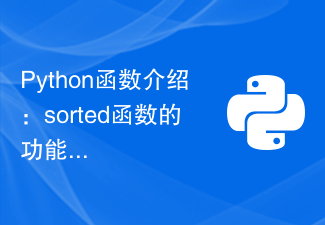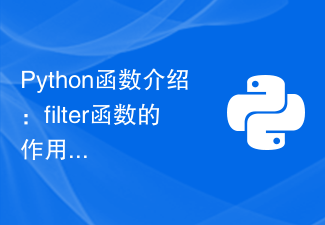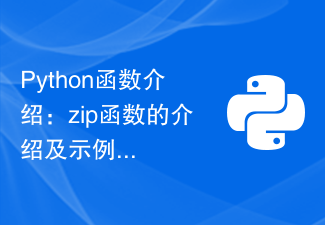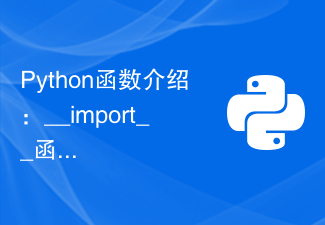 Backend Development
Backend Development Python Tutorial
Python Tutorial Introduction to Python functions: introduction and examples of tuple functions
Introduction to Python functions: introduction and examples of tuple functions
Introduction to Python functions: introduction and examples of tuple function
In the Python programming language, tuple (tuple) is an immutable ordered data type. It is similar to a list, but unlike a list, a tuple cannot be modified once it is created. Tuples can contain different types of data and are represented by parentheses (). The tuple function is one of Python's built-in functions, used to convert a sequence (list, string, or other iterable object) into a tuple. This article will introduce the usage of tuple function and provide corresponding sample code.
The usage of tuple function is as follows:
tuple(iterable)
where iterable is any iterable object, such as list, string, etc. The function returns a tuple containing all elements in the iterable.
Here are a few examples to help us better understand the usage of the tuple function.
Example 1:
Suppose we have a list that stores the names of some employees:
names = ['Alice', 'Bob', 'Charlie', 'David' ]
We can use the tuple function to convert this list into a tuple:
tuple_names = tuple(names)
print(tuple_names)
Run the above code, the output will be as follows:
('Alice', 'Bob', 'Charlie', 'David')
Example 2:
We can also use the tuple function to convert a string into a tuple. Consider the following example:
string = 'Hello, World!'
We can convert a string into a tuple by passing it to the tuple function:
tuple_string = tuple(string )
print(tuple_string)
Run the above code, the output result is as follows:
('H', 'e', 'l', 'l', 'o', ',', ' ', 'W', 'o', 'r', 'l', 'd', '!')
Example 3:
Not only can lists and strings be converted to tuples, but also Convert other iterable objects to tuples. Let’s look at an example:
range_obj = range(1, 6)
We can convert the range object into a tuple:
tuple_range = tuple(range_obj)
print( tuple_range)
Run the above code, the output result is as follows:
(1, 2, 3, 4, 5)
Summary:
Through the tuple function, we can easily combine a list, Convert a string or other iterable object to a tuple. Tuples are more suitable than lists in some scenarios because they are immutable, which means that their elements cannot be modified. The tuple function is one of the powerful functions built into Python and is very practical when processing data.
The above is the introduction and examples of the tuple function. I hope the content of this article will be helpful to everyone's understanding of the tuple function and its usage.
The above is the detailed content of Introduction to Python functions: introduction and examples of tuple functions. For more information, please follow other related articles on the PHP Chinese website!
 Python函数介绍:exec函数的介绍及示例Nov 03, 2023 pm 02:09 PM
Python函数介绍:exec函数的介绍及示例Nov 03, 2023 pm 02:09 PMPython函数介绍:exec函数的介绍及示例引言:在Python中,exec是一种内置函数,它用于执行存储在字符串或文件中的Python代码。exec函数提供了一种动态执行代码的方式,使得程序可以在运行时根据需要生成、修改和执行代码。本文将介绍exec函数的使用方法,并给出一些实际的代码示例。exec函数的使用方法:exec函数的基本语法如下所示:exec
 Python函数介绍:abs函数的用法和示例Nov 03, 2023 pm 12:05 PM
Python函数介绍:abs函数的用法和示例Nov 03, 2023 pm 12:05 PMPython函数介绍:abs函数的用法和示例一、abs函数的用法介绍在Python中,abs函数是一个内置函数,用于计算给定数值的绝对值。它可以接受一个数字参数,并返回该数字的绝对值。abs函数的基本语法如下:abs(x)其中,x是要计算绝对值的数值参数,可以是整数或浮点数。二、abs函数的示例下面我们将通过一些具体的示例来展示abs函数的用法:示例1:计算
 Python函数介绍:sorted函数的功能和示例Nov 03, 2023 pm 02:47 PM
Python函数介绍:sorted函数的功能和示例Nov 03, 2023 pm 02:47 PMPython函数介绍:sorted函数的功能和示例Python是一门非常强大的编程语言,拥有丰富的内置函数和模块。在这个系列文章中,我们将逐一介绍Python常用的函数,并提供相应的示例来帮助读者更好地理解和应用这些函数。本篇文章将详细介绍sorted函数的功能和示例。sorted函数用于对可迭代对象进行排序,并返回排序后的新列表。可以用于对数字、字
 PHP中endwhile关键字的作用和示例Jun 28, 2023 pm 08:00 PM
PHP中endwhile关键字的作用和示例Jun 28, 2023 pm 08:00 PMPHP中endwhile关键字的作用和示例在PHP中,endwhile是一种控制结构,用来实现while循环。它的作用是让程序在满足指定条件的情况下,重复执行一段代码块,直到条件不再满足。endwhile的语法形式如下:while(condition)://循环体代码endwhile;在这个语法中,condition是一个逻辑表达式,当该表达
 Python函数介绍:filter函数的作用和示例Nov 04, 2023 am 10:13 AM
Python函数介绍:filter函数的作用和示例Nov 04, 2023 am 10:13 AMPython函数介绍:filter函数的作用和示例Python是一种功能强大的编程语言,提供了许多内置的函数,其中之一就是filter函数。filter函数用于过滤列表中的元素,并返回满足指定条件的元素组成的新列表。在本文中,我们将介绍filter函数的作用,并提供一些示例来帮助读者理解其用法和潜力。filter函数的语法如下:filter(function
 Python函数介绍:zip函数的介绍及示例Nov 03, 2023 pm 02:02 PM
Python函数介绍:zip函数的介绍及示例Nov 03, 2023 pm 02:02 PMPython函数介绍:zip函数的介绍及示例Python是一种高级语言,它提供了许多有用的函数来帮助开发人员快速地编写程序。其中一个函数就是zip函数。Zip函数是Python中的内置函数之一,它可以接受一组可迭代对象(包括列表、元组、集合和字典等),并返回一个由这些可迭代对象中的元素按顺序成对组成的元组。Zip函数可以用于多种情况,例如:1.将两个列表的元
 Python函数介绍:__import__函数的用法和示例Nov 03, 2023 pm 06:15 PM
Python函数介绍:__import__函数的用法和示例Nov 03, 2023 pm 06:15 PMPython函数介绍:__import__函数的用法和示例Python作为一门高级编程语言,其强大的函数库以及函数的使用方法也是吸引越来越多开发者以及爱好者的原因之一。在Python中,内置的__import__函数是一个非常强大但比较少用的函数,该函数用于动态导入模块。它接收静态的模块名称并返回已导入的模块对象。Syntax:import(name[,
 PHP的array_walk()函数介绍及示例使用Jun 27, 2023 pm 03:31 PM
PHP的array_walk()函数介绍及示例使用Jun 27, 2023 pm 03:31 PM在PHP中,有很多实用的函数可以帮助我们更方便地处理数组。其中,array_walk()函数就是一个非常实用的函数,它可以对数组中的每个元素进行指定的操作,让我们来了解一下。array_walk()函数介绍array_walk()函数是一个用于处理数组的函数,它的语法结构如下:array_walk(array&$array,callable$callb


Hot AI Tools

Undresser.AI Undress
AI-powered app for creating realistic nude photos

AI Clothes Remover
Online AI tool for removing clothes from photos.

Undress AI Tool
Undress images for free

Clothoff.io
AI clothes remover

AI Hentai Generator
Generate AI Hentai for free.

Hot Article

Hot Tools

Atom editor mac version download
The most popular open source editor

mPDF
mPDF is a PHP library that can generate PDF files from UTF-8 encoded HTML. The original author, Ian Back, wrote mPDF to output PDF files "on the fly" from his website and handle different languages. It is slower than original scripts like HTML2FPDF and produces larger files when using Unicode fonts, but supports CSS styles etc. and has a lot of enhancements. Supports almost all languages, including RTL (Arabic and Hebrew) and CJK (Chinese, Japanese and Korean). Supports nested block-level elements (such as P, DIV),

SublimeText3 Linux new version
SublimeText3 Linux latest version

VSCode Windows 64-bit Download
A free and powerful IDE editor launched by Microsoft

ZendStudio 13.5.1 Mac
Powerful PHP integrated development environment





